STUDY THE EFFECT OF AWASSI EWE LAMBS BODY WEIGHT ON SOME REPRODUCTION EFFICACY PARAMETERS
Abstract
The study was crried out at the animal farm Animal Resources Department College of Agriculture and Forestry-University of Mosul, in order to evaluate the effect of body weight on carcass weight and some body fat measurements, and its relation with the reproductive capacity . 75 female lambs were divided at the puberty age into three weight groups (25animal. Each) the 1st . group High weight (38-44 kg) , 2nd group Intermediate weight (33.5-37.5 kg) , and 3rd group : Low weight (28-32.5 kg) . Five lambs were slaughtered in order to study the body fat parameters and the reproductive system development , The remaining lambs (20 femal lambs/group) were subjected to estrous synchronization by progesterone vaginal sponges for 12 days , then when the sponges removed , the lambs were injected with 500 U of eCG.
Result revealed a significant increase in carcass weight , tail weight , abdominal fat , kidney's fat and tail weight : carcass weight % and body fat : carcass weight % in the high weight group as compared with low weight group , and a significant or arithmetic increase in high weight group in reproductive system parameters including : reproductive system weight , ovaries weight , oviducts weight and uterine horns length as compared with the other two groups .
Results also revealed that the best fertilization rate , fertility and lambing% at weaning in the ewes of high and intermediate groups as compared with low weight group . In conclusions , it is possible to mate the Awassi female lamb with high ( > 38 kg) and intermediate body weight (> 33.5 -37.5 kg) at early ages .




